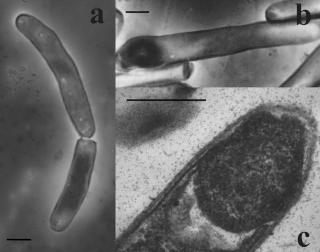Related Research Articles
Methanococcus is a genus of coccoid methanogens of the family Methanococcaceae. They are all mesophiles, except the thermophilic M. thermolithotrophicus and the hyperthermophilic M. jannaschii. The latter was discovered at the base of a “white smoker” chimney at 21°N on the East Pacific Rise and it was the first archaeal genome to be completely sequenced, revealing many novel and eukaryote-like elements.
In taxonomy, the Desulfurococcaceae are a family of the disc-shaped anaerobic microorganisms belonging to the order Desulfurococcales, in the domain Archaea. Members of this family are distinguished from the other family (Pyrodictiaceae) in the order Desulfurococcales by having an optimal growth temperature below 100 °C, rather than above 100 °C, and by being more diverse. Several genera of the family have been identified.
In taxonomy, Methanobacterium is a genus of the Methanobacteriaceae family of Archaea. Despite the name, this genus belongs not to the bacterial domain but the archaeal domain. Methanobacterium are nonmotile and live without oxygen. Some members of this genus can use formate to reduce methane; others live exclusively through the reduction of carbon dioxide with hydrogen. They are ubiquitous in some hot, low-oxygen environments, such as anaerobic digestors, their wastewater, and hot springs.
The Chloroflexota are a phylum of bacteria containing isolates with a diversity of phenotypes, including members that are aerobic thermophiles, which use oxygen and grow well in high temperatures; anoxygenic phototrophs, which use light for photosynthesis ; and anaerobic halorespirers, which uses halogenated organics as electron acceptors.
Armatimonadota is a phylum of gram-negative bacteria.
Thermacetogenium phaeum is a bacterium, the type species of its genus. It is strictly anaerobic, thermophilic, syntrophic and acetate-oxidizing. Its cells are gram-positive, endospore-forming and rod-shaped. Its type strain is PBT. It has a potential biotechnological role.
Syntrophomonas palmitatica is a bacterium. It is anaerobic, syntrophic and fatty acid-oxidizing. Its type strain is GB8-1T. Cells are slightly curved, non-motile rods.

"Syntrophothermus lipocalidus" is a bacterium, the type species and only currently described species in its genus. It is thermophilic, syntrophic, fatty-acid-oxidizing and anaerobic, and utilises isobutyrate. TGB-C1T is its type strain. Its genome has been fully sequenced.
Pelotomaculum thermopropionicum is an anaerobic, thermophilic, syntrophic propionate-oxidizing bacterium, the type species of its genus. The type strain is strain SI(T).
Methanocella paludicola is a methane-producing archaeon, the type species of its genus. It was first isolated from rice paddy soil, and is mesophilic and hydrogenotrophic, with type strain SANAET.

Syntrophothermus is a bacterial genus from the family of Syntrophomonadaceae. Up to now there is only on species of this genus known.

Carboxydocella is a Gram-positive and obligate anaerobe bacterial genus from the family of Syntrophomonadaceae.
Caldanaerobius is a genus of thermophilic, obligately anaerobic bacteria from the family of Thermoanaerobacteraceae.
Carboxydothermus is a genus of thermophilic, anaerobic bacteria from the family of Thermoanaerobacteraceae.
Tepidanaerobacter is a genus of anaerobic, moderately thermophilic, syntrophic bacteria from the family Tepidanaerobacteraceae.
Tepidanaerobacter syntrophicus is an anaerobic, moderately thermophilic and syntrophic bacterium from the genus of Tepidanaerobacter which has been isolated from sewage sludge in Niigata in Japan.
Anaerolineaceae is a family of bacteria from the order of Anaerolineales. Anaerolineaceae bacteria occur in marine sediments. There are a total of twelve genera in this family, most of which only encompass one species. All known members of the family are Gram-negative and non-motile. They also do not form bacterial spores and are either mesophilic or thermophilic obligate anaerobes. It is also known that all species in this family are chemoheterotrophs.
Bellilinea is a thermophilic bacteria genus from the family of Anaerolineaceae with one known species. Bellilinea caldifistulae has been isolated from thermophilic digester sludge from Niigata in Japan.
Leptolinea is a bacteria genus from the family of Anaerolineaceae with one known species.
Longilinea is a bacteria genus from the family of Anaerolineaceae with one known species. .
References
- 1 2 3 A.C. Parte; et al. "Pelotomaculum". List of Prokaryotic names with Standing in Nomenclature (LPSN). Retrieved 2022-09-09.
- ↑ Paul, De Vos (2009). Bergey's manual of systematic bacteriology (2nd ed.). Dordrecht: Springer. ISBN 978-0-387-68489-5.
- ↑ Patrick C., Hallenbeck (2012). Microbial technologies in advanced biofuels production (1 ed.). New York: Springer. ISBN 978-1-4614-1207-6.
- ↑ UniProt
- ↑ Sayers; et al. "Pelotomaculum". National Center for Biotechnology Information (NCBI) taxonomy database. Retrieved 2022-09-09.
- ↑ "The LTP" . Retrieved 23 February 2022.
- ↑ "LTP_all tree in newick format" . Retrieved 23 February 2022.
- ↑ "LTP_01_2022 Release Notes" (PDF). Retrieved 23 February 2022.
- ↑ "GTDB release 07-RS207". Genome Taxonomy Database . Retrieved 20 June 2022.
- ↑ "bac120_r207.sp_labels". Genome Taxonomy Database . Retrieved 20 June 2022.
- ↑ "Taxon History". Genome Taxonomy Database . Retrieved 20 June 2022.